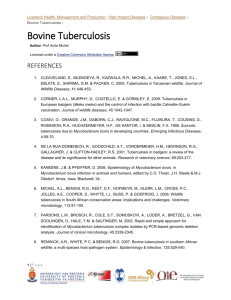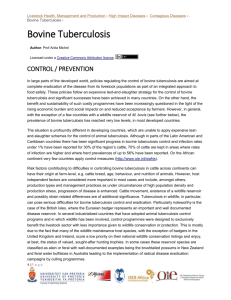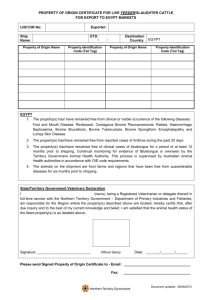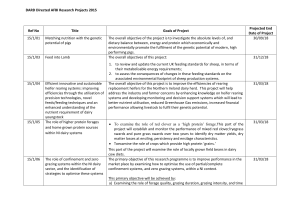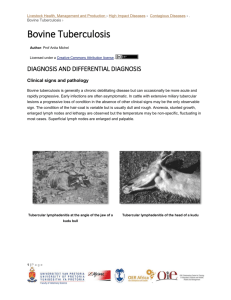tb_fs
advertisement
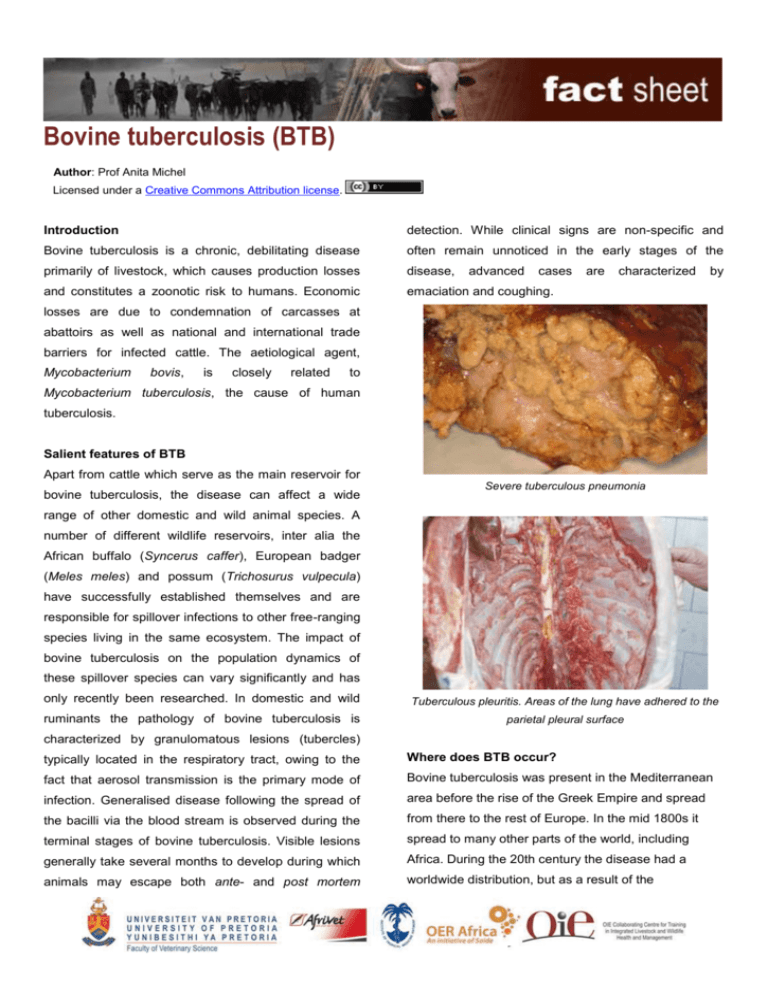
Bovine tuberculosis (BTB) Author: Prof Anita Michel Licensed under a Creative Commons Attribution license. Introduction detection. While clinical signs are non-specific and Bovine tuberculosis is a chronic, debilitating disease often remain unnoticed in the early stages of the primarily of livestock, which causes production losses disease, and constitutes a zoonotic risk to humans. Economic emaciation and coughing. advanced cases are characterized by losses are due to condemnation of carcasses at abattoirs as well as national and international trade barriers for infected cattle. The aetiological agent, Mycobacterium bovis, is closely related to Mycobacterium tuberculosis, the cause of human tuberculosis. Salient features of BTB Apart from cattle which serve as the main reservoir for bovine tuberculosis, the disease can affect a wide Severe tuberculous pneumonia range of other domestic and wild animal species. A number of different wildlife reservoirs, inter alia the African buffalo (Syncerus caffer), European badger (Meles meles) and possum (Trichosurus vulpecula) have successfully established themselves and are responsible for spillover infections to other free-ranging species living in the same ecosystem. The impact of bovine tuberculosis on the population dynamics of these spillover species can vary significantly and has only recently been researched. In domestic and wild Tuberculous pleuritis. Areas of the lung have adhered to the ruminants the pathology of bovine tuberculosis is parietal pleural surface characterized by granulomatous lesions (tubercles) typically located in the respiratory tract, owing to the Where does BTB occur? fact that aerosol transmission is the primary mode of Bovine tuberculosis was present in the Mediterranean infection. Generalised disease following the spread of area before the rise of the Greek Empire and spread the bacilli via the blood stream is observed during the from there to the rest of Europe. In the mid 1800s it terminal stages of bovine tuberculosis. Visible lesions spread to many other parts of the world, including generally take several months to develop during which Africa. During the 20th century the disease had a animals may escape both ante- and post mortem worldwide distribution, but as a result of the implementation of eradication programmes, especially herds classified as infected are placed under in the developed world, many countries have now quarantine with repeat testing and slaughter of all test achieved a bovine tuberculosis free status. In large positive animals until the herd is considered free of parts of the developing world, however, no eradication infected animals. The interferon gamma assay is an or control measures for bovine tuberculosis exist and ancillary test which can be used for increased often no information on the occurrence of the disease sensitivity in the eradication of bovine tuberculosis from is available. Under these circumstances the risk of so-called problem herds. spillover infection of M. bovis to humans is highest as milk is largely consumed unpasteurised. At the same Once bovine tuberculosis has established itself in a time a high incidence of human tuberculosis is the wildlife population it is considered impossible to reason that diagnostic services generally do not make eradicate provision for differentiation between tuberculous impractical and too expensive to apply. Vaccination agents. has been discussed as the only practical option to as a test-and-slaughter approach is control bovine tuberculosis in countries where a wildlife Despite the success in the eradication of bovine reservoir of the disease is present. Although at present tuberculosis in cattle the establishment of wildlife no vaccine with proven efficacy exists for immunizing reservoirs has led to the recurrence of the disease in animals or humans, recent research has shown some countries (e.g. UK and New Zealand) and is promising results in animal experiments. posing a new threat to the livestock sector. Find out more What triggers an outbreak of BTB? The CPD module on bovine tuberculosis describes, on Movement of infected cattle to previously uninfected the herds is the main cause of new outbreaks of bovine pathogenesis to refresh the basic knowledge on the tuberculosis. This may be facilitated by the lack of topic. On the other hand the module places a large reliable diagnostic tools for early identification of emphasis on the epidemiology and implications of the outbreaks, a lack of adequate quarantine measures or disease on the wildlife/lllivestock/human interface non-compliance by farmers with quarantine measures. including its socio-economic effects. In situations of uncontrolled contact between livestock Other relevant CPD courses and wildlife, also referred to as the wildlife/livestock interface, bovine tuberculosis can be freely transmitted between them. As disease monitoring and intervention is extremely difficult at the interface, outbreaks often remain undetected. Prevention and control The control of bovine tuberculosis in cattle traditionally relies on the use of the tuberculin skin test in combination with the slaughter of positive reactor animals. For this purpose, the control scheme requires all cattle herds to be tested at regular intervals and one hand, the disease Laboratory Diagnostics characteristics and
